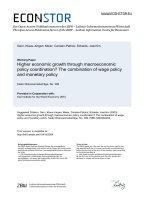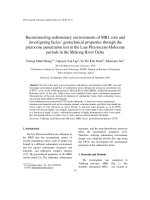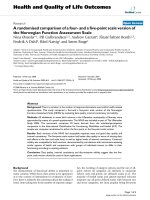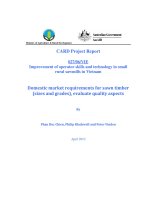(EC 302 589) MUSIC: GRADES FIVE THROUGH EIGHT BLACK SWAMP ARTS SCENE COURSE OF STUDY: TALENTED AND GIFTED
Bạn đang xem bản rút gọn của tài liệu. Xem và tải ngay bản đầy đủ của tài liệu tại đây (976.44 KB, 48 trang )
<span class="text_page_counter">Trang 1</span><div class="page_container" data-page="1">
<small>DOCUMENT RESUME</small>
<small>TITLEMusic: Grades Five through Eight. Black Swamp ArtsScene Course of Study: Talented and Gifted.</small>
<small>INSTITUTIONDefiance County Office of Education, OH.</small>
<small>NOTE</small> <sub>48p.; For related documents, see EC 302 590-591.</sub> <small>PUB TYPEGuidesClassroom UseTeaching Guides (For</small>
<small>Teacher) (052)</small>
<small>EDRS PRICE</small> <sub>MF01/PCO2 Plus Postage.</sub>
<small>DESCRIPTORS</small> <sub>Acceleration (Education); Educational Philosophy;</sub> <small>Elementary School Students; Enrichment Activities;*Gifted; Intermediate Grades; Junior High Schools;Junior High School Students; *Music Appreciation;*Music Education; *Music Theory; Public Schools;Sequential Learning; *Talent; Units of StudyABSTRACT</small>
<small>This course of study was developed for intermediateand junior high students in the Defiance (Ohio) public schools whoare talented and gifted in music, providing for an indepth andsequential development of the skills and concepts involved. Theprogram's philosophy stresses that, while the products of the artsare important, a need exists to emphasize the learning process assatisfying in and of itself. It focuses on sensitizing the wholeperson to the arts and to developing the imagination. Options inmeeting the needs of gifted students in music include accelerated</small>
<small>educational experiences in cluster groups within regular classroomsor in enriched music classrooms serving gifted children. A scope andsequence chart for grades 5 through 8 lists program and subjectobjectives for several components of a music curriculum, coveringpitch, duration, timbre, texture, form, and style. A scope andsequence chart for music theory/appreciation addresses the samecurriculum components in addition to loudness and technicalobjectives. Methods of evaluating student progress are noted.</small>
<small>***********************************************************************Reproductions supplied by EDRS are the best that can be made</small>
<small>from the original document.</small>
<small>***********************************************************************</small>
</div><span class="text_page_counter">Trang 2</span><div class="page_container" data-page="2">Defilnce City and County Schools
Course of Study Talented and Gifted
Grades Five through Eight
BEST GOY MlAHE
<small>omce 01 Educations; Research an0 ImprovementEDUCATIONAL RESOURCES INFORMATION</small>
<small>CENTER IERICI</small>
<small>(TMs document has been reproduced aseceived from the person ororganizationOnginating</small>
<small>r Minor changes have been mace</small><sup>to improve</sup> <small>reproduction 01.Ak0y</small>
<small>Points of view or opiMons sta:ed.,10,5</small><sup>docui</sup> <small>ment 00 001 necessams</small><sup>'eoresent official</sup> <small>OE RI position or POhnv</small>
<small>"PERMISSION TO REPRODUCE THISMAT</small> <sup>L HAS BEEN GRANTED</sup><sup>BY</sup>
<small>TO THE EDUCATIONAL RESOURCESINFORMATION CENTER (ERIC1</small>
</div><span class="text_page_counter">Trang 3</span><div class="page_container" data-page="3">Grades Five through Eight:
<small>1,,</small>
</div><span class="text_page_counter">Trang 4</span><div class="page_container" data-page="4">This Black Swamp Arts Scene Course of Study was developed<sup>for students who</sup> are talented and<sup>gifted in the visual ancVor</sup><sup>performing arts. It provides for an in-depth and</sup>
sequential development of the skills and concepts involved within the arts discipline at hand. This growth will be greatly<sup>enhanced by regular use of the widely accepted teaching</sup>
methods known to be suitable for talented and gifted students.
This course of study is not intended to be a prescribed route<sup>which all students must</sup>
follow. Rather, it is meant to be a<sup>framework for learning the content</sup><sup>included herein. It is</sup>
assumed that the individual teacher will deliver specific<sup>learning prescriptions with</sup>
flexibility and sensitivity to the<sup>mental and/or emotional needs</sup>of gifted learners. Neitherthe teacher nor the student is expected to use it in it's entirety or<sup>in one specific sequence.</sup>
</div><span class="text_page_counter">Trang 5</span><div class="page_container" data-page="5">PROGRAM PHILOSOPHY
Thc value of the visual and performing arts to <sup>society is the opportunity which</sup>
exists to develop a literacy, a means whereby the individuals<sup>which make up the society are</sup>
free to both experience and express humanity. <sup>While the products of the arts are important,</sup>
a need exists to <sup>emphasize the learning process as</sup><sup>satisfying in and of itself. The skills of</sup>
both performance and
<sup>production are essential.</sup><sup>Included in the affective range</sup>of a
person's nature are the
<sup>attributes of caring, appreciation and acceptance</sup><sup>of individual</sup>
differences. Promotion of an environment <sup>which encourages</sup>self-er.eem is not only
desirable but required.
Our focus is, then, on sensitizing the whole person to<sup>the arts and to developing the</sup>
imagination. As the arts cross<sup>cultural and societal boundaries, traditional subject</sup><sup>matter is</sup> integrated. Common threads of knowledge<sup>and,understanding connect diverse fields of</sup>
study through arts programming. Thus, to provide<sup>opportunities for individuals to</sup>
formulate questions, problems<sup>and goals related to life becomes our highest</sup><sup>priority in the</sup>school environment.
- 2
5
</div><span class="text_page_counter">Trang 6</span><div class="page_container" data-page="6">PROGRAM GOALS
A. <sup>To provide enriched settings which encourage open-ended learning</sup>
B. To facilitate the development of a positive self-concept
C. To nurture, accept and strengthen creative behaviors
D. <sup>To increase the vital skills of problem solving</sup>
E. To gain an understanding of and facility with the communication<sup>through the arts</sup>
F.
To groom students to be leaders by encouraging initiative and independenceG.
To develop an understanding and appreciation of social cooperation and responsibilityH.
To gain an understanding of school experiences as they relate to planning <sup>for future</sup> careersI. To build enthusiasm for life-long learning
J.
To increase understanding of "change" as a natural and manageable phenomenonK.
To be hopeful, joyous and capable in meeting the challenges in the<sup>future</sup>- 3
fi
</div><span class="text_page_counter">Trang 7</span><div class="page_container" data-page="7">DEFIANCE CITY SCHOOL DISTRICT PROGRAM <sup>PHILOSOPHY</sup>
<small>1.1General Philosophy of Education for Defiance City Schools</small>
<small>Education in the Defiance City Schoolsis based on the recognition of the</small><sup>dignity and worth of each</sup>
<small>student the ability to communicate and to be communicated with; second, toacquaint the</small>
<small>student with those facts, ideologies, and techniques upon which modem</small><sup>cultures have been</sup> <small>built; and third, to foster in each student the desire to arrive at independent</small><sup>conclusions after an</sup>
<small>openminded consideration of all available information.</small>
<small>and reinforce those moral, spiritual and patriotic values upon which our ownculture has beenbuilt.</small>
<small>formal classes designed specifically for this purpose, since every class presents manyopportunities to effectively reinforce our own mores.</small>
<small>D.That life in a technological world requires continual and rapid readjustment and</small><sup>careful </sup> <small>re-evaluation, but we believe that these necessary</small><sup>changes can best be made from a firm</sup><small>base if</small>
<small>established human values.</small>
<small>1.2Goals of Education for Defiance City Schools</small>
<small>A.</small> <sup>To be continually aware of the educational needs of all members of the community</sup><sup>and,</sup>
<small>insofar as financially possible, provide the meansof fulfilling those needs.</small>
<small>B.</small> <sup>To provide remedial work in the basics, particularly reading, for those</sup><sup>students whose</sup>
<small>achievement is considerably lower than thUr grade placement.</small>
<small>his/her own abilities.</small>
<small>experimentation and change.</small>
<small>E.</small> <sup>To provide each student with competent assistance and advice in choosing a</sup><sup>vocational goal.</sup>
F. <small>To provide each student with experiences, examples and instruction which will</small><sup>assist and</sup> <small>encourage the student to:</small>
3. <small>Recognize his/her own worth as anindividual.</small>
4. <small>Develop self-discipline.</small>
<small>7.Avoid economic pitfalls as a consumer.</small>
<small>8.</small> <sup>Develop an appreciation of the fine arts.</sup>
<small>9.Recognize the needs for continuous learning and self-improvement.</small>
<small>10.Become a responsible citizen.</small>
<small>1 1.Strive for economic independence.</small>
<small> 4 </small>
</div><span class="text_page_counter">Trang 8</span><div class="page_container" data-page="8">-DEFIANCE COUNTY SCHOOL DISTRICT PROGRAM <sup>PHILOSOPHY</sup>
the United States, and in Defiance <sup>County in particular, the County</sup> <sup>Board of Education believes that</sup>
To attain these goals it is the<sup>responsibility of the school to provide the necessary training to</sup> develop basic skills. TL school must <sup>help students develop attitudes so that desired intellectual, moral,</sup>
<small>To teach the basic skills, develop creative attitudes, concepts, andjudgements, the curriculum must</small>
<small>each student.</small>
<small> 5 </small>
-a
</div><span class="text_page_counter">Trang 9</span><div class="page_container" data-page="9">BLACK SWAMP ARTS SCENE DEFIANCE CITY & COUNTY SCHOOLS
Course of Study for Talented and Gifted
Implementation of ProcessModel
Educational Program
The following supportive services and experiences are some<sup>ways to serve</sup><sup>students gifted</sup>
in the visual and performing arts<sup>as part of the</sup> <sup>regular educational program. Black Swamp</sup>
Arts Scene provides pre-, post-school, or Saturday <sup>options as well as regularly scheduled</sup>
arts classes to satisfy the required number<sup>of minutes per week.</sup>
As stated in the
<sup>Rule For School Foundation Units for Gifted</sup> <sup>Children (3301-51-15)</sup> E.2.1.e: Program eligibility shall reflect the criteria<sup>defined by the state rule determining</sup> eligibility. The gifted child<sup>shall receive a minimum of five hours per week of</sup><sup>instructional</sup>services as defined in paragraph E.2.c. of the rule.
Black Swamp Arts Scene recognizes the following<sup>options:</sup>
<small>1.</small> Accelerated educational experiences:
a. <sup>Advanced subject matter programs which may include the</sup><sup>following:</sup>
<small>1)</small> Honors bands, choirs,<sup>orchestras, .or ensembles</sup>
2) Music topic seminars,<sup>honors couries, or</sup><sup>residencies</sup>
3) <sup>Independent study and research</sup>
4) <sup>Perfprming arts experiences, including theory or appreciation</sup>
5) Mentorships, internships, and other intensive work<sup>with experts in a</sup> given field of study
6) Concurrent enrollment at another school or training agency
b. Guidance services might include the following:
<small>1)</small> Personal/social awareness and adjustment 2) <sup>Academic planning and performance</sup>
3) <sup>Vocational and career awareness, investigation, and planning</sup>
6
</div><span class="text_page_counter">Trang 10</span><div class="page_container" data-page="10">-Black Swamp Arts Scene
Defiance City & County Schools
Course of Study for Talented and Gifted Implementation of Process Model
2. Organizational option:
a. <sup>Cluster grouping shall provide for full-time placement of two or more</sup>
gifted children identified in accordance with state standards in the regular educational classroom. The classroom teacher will extend, replace, and/or supplement the regular school program by providing
appropriate special instruction for the gifted child during the regular school day.
b. <sup>Enriched music classroom shall serve gifted children identified in</sup>
accordance with state standards on a part-time basis, and shall provide instructional services different from those normally provided in the regular classroom. The children shall have the opportunity to work at their level of ability and in their area of interest and to interact with other gifted children for at least part of the regular school day.
<small>S.</small>
</div><span class="text_page_counter">Trang 11</span><div class="page_container" data-page="11">Black Swamp Arts Scene
Defiance City & County Schools
Course of Study for Talented and Gifted Grades Five through Eight General Music
Key to Scope and Sequence Charts
A. The program objective will be listed.
B. <sup>Subject objectives will be listed and will be coded with a number and a point zero</sup> number designating the sub-objectives.
C. Skill level for subject objectives:
</div><span class="text_page_counter">Trang 12</span><div class="page_container" data-page="12">Scope and Sequence
Talented and Gifted Grades<sup>Five through Eight, "General Music"</sup>
I = Introduce; D = Develop; T = Test; R = Reinforce/Maintain
<small>1.</small> The learner visually and aurally identifies the member tones oftriads
1.1 The learner plays, sings,<sup>and</sup>
notates triads
2.
The learner identifies the member tones of triads2.1 The learner sings-Ariads with
letter names and numbers
3.
The learner identifies the intervals found in triads3.1
The learner sings, <sup>Plays, and notates</sup>major-minor triads and perfect fifths <sub>11,</sub>
4.
The learner identifies chord degrees as root,third, and fifth
5.
The learner visually and aurally identifies triads as being either major or minor5.1 The learner changes major<sup>chords to</sup> minor, minor chords to major
6.
The learner distinguishes major and minor triads from seventh and more complex chords6.1 The learner notates major and minor triads, seventh chords, and more complex chords
7.
The learner distinguishes between root position and their inversions7.1 The learner notates chords and <sup>their</sup> inversions in given keys
</div><span class="text_page_counter">Trang 13</span><div class="page_container" data-page="13">Scope and Sequence
Talented and Gifted Grades Five through Eight, "General <sup>Music"</sup>
I = Introduce; D = Develop; T = Test; R = Reinforce/Maintain
5 6 7
8
7.2
The learner performs chord progressions that demonstrate the need for chord inversions (e.g., voice leading)8. <sup>The learner explains the manner in which chords</sup> <sup>I</sup> DTR DTR DTR
are related to a tonal center
9. The learner visually and aurally identifies primary and secondary chords by labeling them according to letter name (e.g., 07, and
function, e.g., V7)
9.1 <sup>The learner plays or sings primary and</sup>
secondary chords in selected keys
10. The learner identifies <sup>the need for chord</sup>
changes when listening to or accompanying melodies
10.1 <sup>The learner harmonizes phrase en,:ings</sup>
of songs
11. The learner assesses<sup>the appropriateness of</sup>
chordal accompaniment to a given melodic line
11.1 The learner harmonizes
nlodic lines by
creating chordal accompaniments
12. The learner identifies<sup>chord changes as they</sup>
occur in music heard or performed
12.1 <sup>The learner plays chord progressions in</sup> response to chord<sup>symbols or numbers</sup>
</div><span class="text_page_counter">Trang 14</span><div class="page_container" data-page="14">Scope and Sequence
Talented and Gifted Grades Five through Eight, "General<sup>Music"</sup>
I = Introduce; D = Develop; T = Test; R = Reinforce/Maintain
5 6 7 8
12.3 <sup>The learner performs accompaniments on</sup> autoharp, guitar, keyboard, or in vocal chording and changes chords as the music demands
13. The learner identifies<sup>chord progressions as</sup> <sup>I</sup> <sup>DTR DTR DTR</sup>
being major or minor
14. The learner identifies<sup>traditional voice</sup>
leading in a chord progression
14.1 <sup>The learner sings or plays, demonstrating</sup> awareness of voice leading by resolving leading tones and dissonances
15. The learner indicates<sup>cadence points in chord</sup>
progressions and describes<sup>cadence as strong</sup>
or weak, or as <sup>full, half, plagal, or</sup><sup>deceptive</sup>
15.1 The learner plays or sings <sup>examples of</sup> full, half, plagal, and deceptive cadences
16. The learner indicates<sup>when modulations occur</sup>
within a composition and identifies clues in scores which indicate modulations
17. The learner, using<sup>technical and nontechnical</sup>
language, describes the rate of harmonic change (harmonic rhythm)
18. The learner describes<sup>the qualitative effects</sup>
of harmonic progressions<sup>in terms of chord</sup> color, tension, and release,<sup>and consonance</sup>
and dissonance
19. The learner identifies<sup>and describes the source</sup>
of dissonance in a particular<sup>progression or</sup>
</div><span class="text_page_counter">Trang 15</span><div class="page_container" data-page="15">Scope and Sequence
Talented and Gifted Grades Five through Eight, "General Music"
I = Introduce; D = Develop; T = Test; R = Reinforce/Maintain
19.1 The learner sings or plays resolutions for dissonances
20. The learner aurally and<sup>visually identifies</sup> nonchord dissonances (e.g., <sup>suspensions,</sup>
appoggiaturas, grace notes)
21. The learner aurally and<sup>visually identifies</sup>
intervals involved in any simultaneous group
of pitches
21.1 The learner notates simultaneous intervals either from aural examples orverbal
22. The learner explains the<sup>need for transposition</sup>
with transposing instruments to accommodate tessitura or range
22.1 <sup>The learner utilizes I, IV, and V chord</sup>
symbols or adapts letter symbols to transpose accompaniments
22.2
The learner transposes familiar passages at appropriate intervals at<sup>sight</sup>23. The learner distinguishes <sup>between pitch and</sup>
other components of composition
23.1 The learner transposes, inverts, and otherwise varies pitch groupings, such
as intervals,<sup>motives, phrases, and</sup> complete melodies
24. The learner describes<sup>and compares the role</sup>
that melodies, tone rows, motives, and other pitch units play in various musical forms
</div><span class="text_page_counter">Trang 16</span><div class="page_container" data-page="16">Scope and Sequence
Talented and Gifted Grades Five through Eight, "General Music"
I = Introduce; D = Develop; T = Test; R = Reinforce/Maintain
5 6 7 8
24.1 The learner creates compositions<sup>based</sup> upon melodies, tone rows, motives, and other pitch units
25. The learner distinguishes<sup>between programmatic</sup> <sup>I</sup>
<sup>DTR DTR DTR</sup>
and absolute approaches to melodic organization
25.1 The learner composes using pitch development to express absolute and programmatic ideas,
(e.g., themes, motives, sequences, and other
melodic patterns)
25.2
The learner selects and utilizesenvironmental and electronicallyproduced
pitch groups to express preconceived ideas
26. The learner identifies ethnic<sup>and nationalistic</sup>
characteristics of pitch organization in both Western and non-Western music
<small>I</small>
DTR DTR DTR
27. The learner describes pitch dimensions of <sup>I</sup>
<sup>DTR DTR DTR</sup>
composition in terms of tension and release
13
-1 6
</div><span class="text_page_counter">Trang 17</span><div class="page_container" data-page="17">Scope and Sequence
Talented and Gifted Grades Five through Eight, "General Music"
I = Introduce; D = Develop; T = Test; R = Reinforce/Maintain
5 6 7 8
1. The learner describes the relationship between <sup>I</sup>
DTR DTR DTR
beat, meter, and rhythmic patterns
1.1 The learner improvises and creates<sup>original</sup> compositions using a variety of tempos, meters, rhythms, and other durational schemes
2.
The learner distinguishes between duration and <sup>I</sup> DTR DTR DTRother components
2.1
The learner performs songs,<sup>dances, and</sup>other compositions demonstrating an awareness of beat, accent, meter, and other durational characteristics
-2.2
The learner conducts appropriate patterns to demonstrate sensitivity to beat, accent,'"
meter, changing meters, rhythmic patterns, syncopation, and other durational schemes
3.
The learner describes how changes in duration are used in creating repetition, contrast, variation, and development3.1
The learner creates and performs compositions using repetition, contrast, and variationsof durational patterns
4.
The learner describes how durational changes reinforce the form of a piece and contribute to its effectiveness<small>I</small> DTR DTR DTR
<small>I</small>
DTR DTR DTR
5.
The learner describes how changes in duration <sup>I</sup>Dia DTR DTR
produce unity and variety in music
5.1 <sup>The learner performs and accurately</sup>
interprets durational (metric or rhythmic) changes
14
-1 7
</div><span class="text_page_counter">Trang 18</span><div class="page_container" data-page="18">Scope and Sequence
Talented and Gifted Grades Five through Eight, "General <sup>Music"</sup>
I = Introduce; D = Develop; T = Test; R = Reinforce/Maintain
5
6
7 86.
The learner describes the relationship between the text <sup>I</sup> DTR DTR DTRof a song and its durational complexity and organization
6.1 <sup>The learner selects and utilizes appropriate</sup>
metric schemes and rhythmic patterns<sup>in</sup> original compositions based on selected texts
7.
The learner describes how the durational scheme <sup>I</sup>DTR DTR DTR
of a piece affects its expressive character
7.1 The learner performs, demonstrating the ability to control and utilize duration for expressive
7.2
The learner creates compositions utilizing durational schemes to express preconceived ideas or intent8.
The learner defends the use of certain durational units or schemes as appropriate or inappropriate to a particular expressive intent9.
The learner describes how duration is used in music to create tension and release10. The learner describes<sup>the importance of silence</sup>
in the organization of musical sounds
10.1 The learner employs silence as an expressive device in original compositions
11. The learner identifies<sup>ethnic and nationalistic</sup>
characteristics of durational organization in botli Western and non-Western<sup>music</sup>
12. The learner describes<sup>general differences in</sup>
durational organization that occur in pop, folk, jazz, country-western, and classical music
</div><span class="text_page_counter">Trang 19</span><div class="page_container" data-page="19">Scope and Sequence
Talented and Gifted Grades Five through Eight, "General Music"
I = I ntrcduce; D = Develop; T = Test; R = Reinforce/Maintain
12.1 The learner improvises on familiar melodies, altering durational organizations (e.g., changing a march to a waltz or tango)
13. The learner describes certain types of
composition (e.g., waltz or march in terms of dominant durational characteristics)
14. The learner describes the relationship <sup>between</sup>
durational organization in music and utilitarian uses of music (e.g., dancing,
worship, work)
15. The learner traces, in a general way,the historical uses of duration in the major style periods of Western music
16. The learner identifies the period of a
composition through a study of its durational characteristics
17. The learner describes appropriatedurational practice for a composition representing a specific style or period
17.1 The learner performs compositions, applying an understanding of durational characteristics of a particular style or iieriod
18. The learner evaluates performances<sup>relating the</sup>
performers' durational interpretation to the period and style of the composition
19. The learner evaluates the rhythmic accuracyof
a performance
20. The learner compares the rhythmicinterpretation of two performances of the same work or works
</div><span class="text_page_counter">Trang 20</span><div class="page_container" data-page="20">Scope and Sequence
Talented and Gifted Grades<sup>Five through Eight, "General Music"</sup> I = Introduce; D =<sup>Develop; T = Test;</sup>
R = Reinforce/Maintain
21. The learner
<sup>describes how composers have imitated</sup>natural and manmad rhythms in their compositions
21.1
The learner creates original compositions employing natural or created rhythms22. The learner
<sup>discusses and compares the use</sup><sup>of</sup> duration in various composers' <sup>styles</sup>23. The learner describes <sup>the degree of rhythmic</sup>
complexity in a given composition in terms of
polymeters, polyrhythms,<sup>irregular meters,</sup> accents, regular meters,<sup>syncopations, and</sup>
other durational characteristics
23.1 <sup>The learner sings and plays a wide variety</sup>
of pieces with varying degrees of rhythmic complexity
23.2
The learner performs demonstrating the ability to interpret and maintain rhythmic accuracy24. The learner assesses<sup>the durational</sup>
appropriateness of accompaniments to these
types of songs: art songs, folk songs, popular songs, children's songs, and arias
</div><span class="text_page_counter">Trang 21</span><div class="page_container" data-page="21">Scope and Sequence
Talented and Gifted Grades Five through Eight, <sup>"General Music"</sup>
I = Introduce; D = Develop; T = Test; R = Reinforce/Maintain
I.
The learner distinguishes between timbre and other components<small>1. 1</small> The learner performs a variety of music demonstrating sensitivity to the
interaction of timbre and other components
2. The learner assesses how changes in other components influence changes in tone color
3.
The learner describes how changes in registers in voices and on various instruments affect tone quality4.
The learner analyzes his own performance<sup>in terms</sup> of tendencies to change tone color as musicchanges in tempo, pitch, and loudness
5.
The learner describes how changes in timbre produce contrast and variety in music5.1 <sup>The learner moves or otherwise indicates</sup>
sensitivity to repeating or contrasting
tone
colors-6.
The learner describes how timbre changes are utilized in creating repetition, contrast,variation, and development in music
6.1
The learner performs musical excerpts on two or more instruments or with two ormore voices and assesses the differences in the effects created
7.
The learner describes how timbre changes reinforce the form of a piece and contribute</div><span class="text_page_counter">Trang 22</span><div class="page_container" data-page="22">Scope and Sequence
Talented and Gifted Grades Five through Eight, "General Music"
I = Introduce; D = Develop; T =<sup>Test;</sup> R = Reinforce/Maintain
7.1 The learner performs a variety of pieces in which formal organization is clearly related to timbral changes
8.
The learner evaluates the expressiveness andinterpretation of a performance in terms of tone color
8.1 <sup>The learner performs, demonstrating</sup><sup>the</sup>
ability to control and utilize timbre<sup>for</sup> expressive changes
8.2
The learner sings and plays a wide variety of literature with appropriate tone quality9.
The learner traces in a general way<sup>the </sup> historical-uses of timbres in the major style periods ofWestern music <sub>1,/</sub>
10. The learner identifies the composer,<sup>style or period</sup>
of a composition through a study of its timbral structure
11. The learner discusses and compares<sup>the use</sup> of tone quality in different<sup>composers'</sup> styles
12. The learner evaluates a<sup>performance, relating</sup>
the performer's control and shading of tone cotor to the period and style df the composition
12.1 <sup>The learner performs musical selections of</sup> various periods and composers, applying appropriate tone colors
13. The learner indicates when tone<sup>colors are</sup>
appropriate or inappropriate for a particular style of music (e.g., vocal quality appropriate
or a folk song as opposed to grand opera or
</div><span class="text_page_counter">Trang 23</span><div class="page_container" data-page="23">Scope and Sequence
Talented and Gifted Grades Five through Eight, "General Music"
I = Introduce; D = Develop; T = Test; R = Reinforce/Maintain
13.1 The learner sings or plays musical excerpts or compositions with tone quality appropriate to the character of the situation
14. The learner describes <sup>general differences</sup>
in timbres that occur in pop, folk, jazz, country-western, and classical music
15. The learner analyzes and <sup>describes program</sup>
music in terms of how timbre is used to portray extramusical ideas
15.1 The learner improvises and creates
programmatic compositions using timbres appropriate to express extramusical
16. The learner describes how<sup>film and television</sup>
music uses timbral effects to reinforce the plot
16.1 <sup>The learner makes videotapes using timbral</sup> effects to develop the plot
17. The learner assesses<sup>when environmental and</sup>
prerecorded sounds are appropriate in a piece
17.1 The learner prepares original compositions employing environmental or prerecorded
18. The learner assesses the<sup>timbral appropriateness</sup> of accompaniments to songs: art songs, <sup>folk</sup> songs, popular songs, and children's songs
18.1 The learner writes accompaniment<sup>for</sup>
different instrumental and vocal combinations demonstrating sensitivity to the melody and text
</div><span class="text_page_counter">Trang 24</span><div class="page_container" data-page="24">Scope and Sequence
Talented and Gifted<sup>Grades Five through Eight, "General Music"</sup>
I = Introduce; D = Develop; T = Test; R = Reinforce/Maintain
19. The learner defends<sup>the use of timbres as</sup>
appropriate or inappropriate to a particular expressive intent
19.1 The learner creates compositions using combinations of timbres to convey an
expressive intent
20. The learner
<sup>discusses the expressive qualities</sup> of a piece in terms of<sup>the composer's use</sup>of
vocal, instrumental, or other timbres
</div>








